How to Keep Moisture Out
One of the most perplexing problems for Backpackers  (Scouts are no exception) is keeping things dry—both themselves and their gear. There is no one solution to this dilemma and you should not think to this problem as a single dimensional one. Rather, approach it as a multidimensional task and attack it on several planes at once. You must have multiple, redundant moisture barriers. Described below is "a system" of steps you can take to keep things dry. For example, the combination of properly fitted pack cover, water resistant pack fabric, and waterproof zip-lock bags provide good assurance against moisture spoiling hike in the rain outweigh the added weight of a few plastic bags. Besides, dry gear is a lot lighter to carry than that which is water soaked. You can be comfortable for a long time under adverse conditions with just a water diverting canopy (dining fly, tent fly, or poncho), and a dry sleeping bag to keep you warm and cozy. Without it you are miserable before very long and possibly at risk of hypothermia.
(Scouts are no exception) is keeping things dry—both themselves and their gear. There is no one solution to this dilemma and you should not think to this problem as a single dimensional one. Rather, approach it as a multidimensional task and attack it on several planes at once. You must have multiple, redundant moisture barriers. Described below is "a system" of steps you can take to keep things dry. For example, the combination of properly fitted pack cover, water resistant pack fabric, and waterproof zip-lock bags provide good assurance against moisture spoiling hike in the rain outweigh the added weight of a few plastic bags. Besides, dry gear is a lot lighter to carry than that which is water soaked. You can be comfortable for a long time under adverse conditions with just a water diverting canopy (dining fly, tent fly, or poncho), and a dry sleeping bag to keep you warm and cozy. Without it you are miserable before very long and possibly at risk of hypothermia.
Here are some things to consider about moisture (getting wet) while backpacking. Let's them one at time.
Keeping YOU Dry
Main Rainwear
Cheap rainwear tears up easily and can leak, leaving you wet and miserable. You don't need to spend a fortune, but you do need to make some wise choices. There are two basic ways to go; a jacket and pants rain suit combination or a poncho.
This is one area where price really makes a difference. There are a few things that you must think  about when you look for good rainwear. First, breath-ability is essential. This lets your body sweat evaporate even when you are wearing the jacket. Rainwear made of waterproof, "breathable" materials like Gore-Tex are top-of the-line when it comes to breath-ability—and usually come with a price to match. If you can't afford the Gore-Tex price tag, look for rainwear that has ventilation flaps and armpit zippers to help you stay cool on those hot rainy days. You are likely going to wear this jacket at some point with your backpack on, so make sure that your pockets are high enough that your hip belt doesn't block access. One plus of a good jacket is that it can often be used as fall/winter wear. If this is your desire, look for a jacket that has a zip in/out liner so you can wear it in colder weather.
about when you look for good rainwear. First, breath-ability is essential. This lets your body sweat evaporate even when you are wearing the jacket. Rainwear made of waterproof, "breathable" materials like Gore-Tex are top-of the-line when it comes to breath-ability—and usually come with a price to match. If you can't afford the Gore-Tex price tag, look for rainwear that has ventilation flaps and armpit zippers to help you stay cool on those hot rainy days. You are likely going to wear this jacket at some point with your backpack on, so make sure that your pockets are high enough that your hip belt doesn't block access. One plus of a good jacket is that it can often be used as fall/winter wear. If this is your desire, look for a jacket that has a zip in/out liner so you can wear it in colder weather.
Pants are considered as part of rainwear. Rather than just being good wind barriers, rain pants can often double as in-camp pants, so you might look for ones that have a reinforced seat.
Military-type ponchos can be one of the most versatile pieces of gear you can pack. Although a rain suit works much better, a poncho can serve a rainwear, a ground cloth, and can even be used in lean-to fashion as a dining fly. 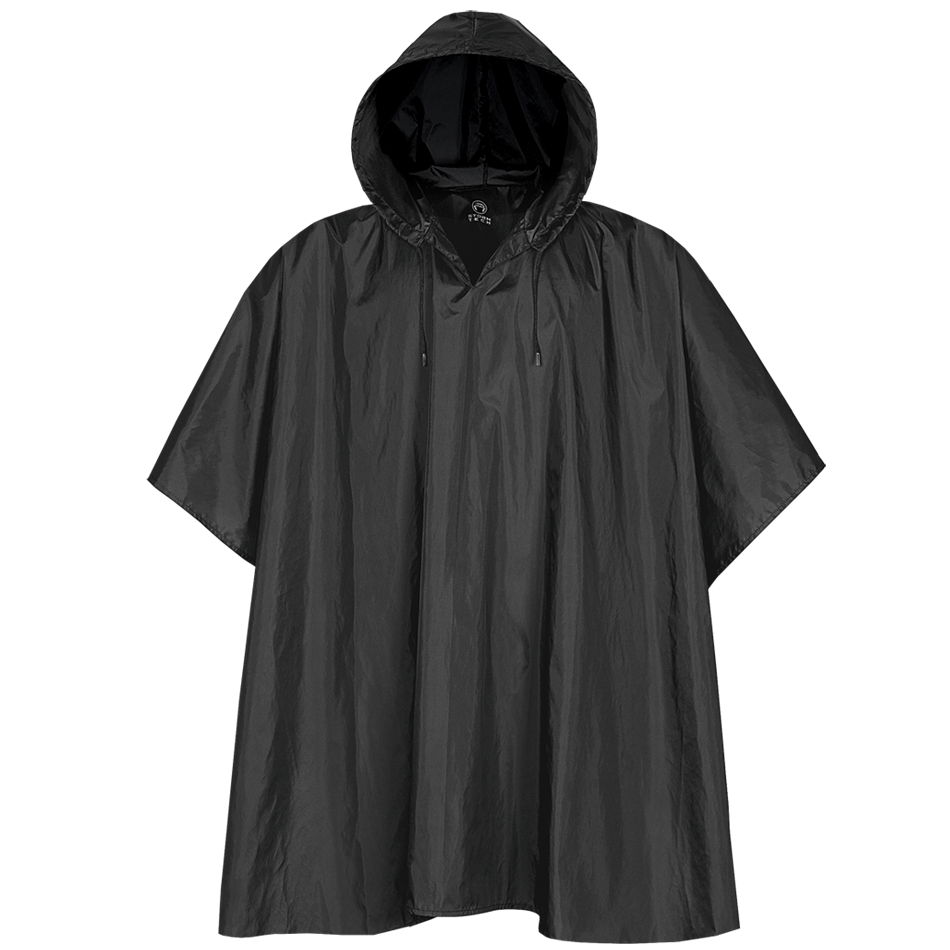 Sturdy ones are made of coated nylon and have side snaps to form rainwear and tie down corner grommets for when used as a cover or shelter (vinyl ones just aren't durable enough for this kind of hard use). Some are available with a "hunchback" specifically intended to cover the hiker and pack together. If carefully selected, a good poncho can even eliminate the need for pack cover. Perhaps the biggest drawback to the poncho as rainwear is that in high winds they can be blown about some allowing water up underneath them.
Sturdy ones are made of coated nylon and have side snaps to form rainwear and tie down corner grommets for when used as a cover or shelter (vinyl ones just aren't durable enough for this kind of hard use). Some are available with a "hunchback" specifically intended to cover the hiker and pack together. If carefully selected, a good poncho can even eliminate the need for pack cover. Perhaps the biggest drawback to the poncho as rainwear is that in high winds they can be blown about some allowing water up underneath them.
Keeping Your Head Dry
One of the best ways to protect your head from the from the rain is with a wide-rimmed hat (no baseball caps allowed!).  You wouldn't think a cloth hat would keep you dry, but it does. Water is wicked to the edge of the rim, where it falls off. Water-resistant coated hats are also available. The wide rim also provides an effective sun shade and prevents things from "dropping down your neck." Vents are a feature to look for. They allow body moisture to escape during warm weather and high humidity that would otherwise be trapped. Rain will run around grommet vents and off the hat.
You wouldn't think a cloth hat would keep you dry, but it does. Water is wicked to the edge of the rim, where it falls off. Water-resistant coated hats are also available. The wide rim also provides an effective sun shade and prevents things from "dropping down your neck." Vents are a feature to look for. They allow body moisture to escape during warm weather and high humidity that would otherwise be trapped. Rain will run around grommet vents and off the hat.
Keeping Your Feet Dry
One problem with hiking in the rain is that your socks can "wick" the moisture into your 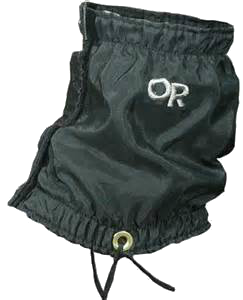 shoes, even if they are waterproof. Waterproof pants that cover the boots will prevent this. Another solution, especially if you are hiking in shorts, is to use gaiters. These are like pants legs from the knee down. They attach at the top with elastic and/or a draw string and often strap under the boot to prevent them from "riding up with wear." They are also good protection in brushy areas and provide some protection from low lying poisonous plants or bugs.
shoes, even if they are waterproof. Waterproof pants that cover the boots will prevent this. Another solution, especially if you are hiking in shorts, is to use gaiters. These are like pants legs from the knee down. They attach at the top with elastic and/or a draw string and often strap under the boot to prevent them from "riding up with wear." They are also good protection in brushy areas and provide some protection from low lying poisonous plants or bugs.
Also consider water-proofed boots. Leather soaks up moisture unless treated. 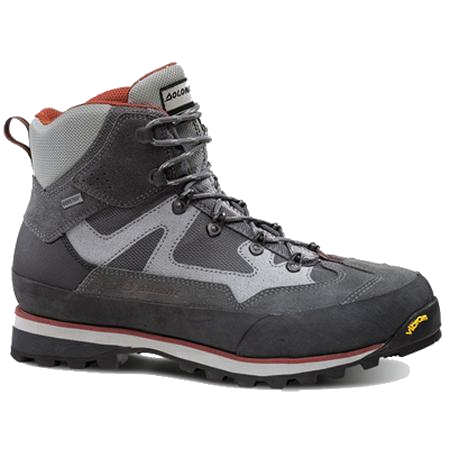 Several preparations, including silicon, seam sealer, and wax-based coatings/penetraters. Another solution is waterproof, breathable liners in the boot. Examples are Gore-tex liners sewn into the boot lining. Even plastic bread-bag liners work for short periods (they aren't breathable so don't wear very long). Rubber/plastic over boots tend to be too heavy and or not durable enough for hiking.
Several preparations, including silicon, seam sealer, and wax-based coatings/penetraters. Another solution is waterproof, breathable liners in the boot. Examples are Gore-tex liners sewn into the boot lining. Even plastic bread-bag liners work for short periods (they aren't breathable so don't wear very long). Rubber/plastic over boots tend to be too heavy and or not durable enough for hiking.
When polypropylene/synthetic liner socks and combined with wool socks, they allow the moisture from your feet to be "wicked away," leaving your feet dryer (not necessarily dry though). They also allow friction to occur between the sock layers rather than against the skin, reducing the chance of blisters. Wool retains some insulating qualities, even when wet. Gore-Tex socks work well too.
Other Ways to Stay Dry
An option most do not think of is using polypropylene/lycra or other synthetic under shorts.  Cotton holds sweat/moisture and dries all too slowly, allowing bacteria to grow and creating an irritating surface for "chaffing." Polypropylene or lycra shorts are typically are longer than boxers or briefs and have a "slippery" surface that eliminate the skin-to-skin rubbing that causes chaffing. They are non-absorbent and allow the moisture to escape. They dry incredibly fast.
Cotton holds sweat/moisture and dries all too slowly, allowing bacteria to grow and creating an irritating surface for "chaffing." Polypropylene or lycra shorts are typically are longer than boxers or briefs and have a "slippery" surface that eliminate the skin-to-skin rubbing that causes chaffing. They are non-absorbent and allow the moisture to escape. They dry incredibly fast.
Hand warmers are a "Hot Hands" charcoal-based disposable warmer is an essential part of the crew first aid kit. It can be put into a sleeping bag to deal with hypothermia or to just help dry it out. They also work well left in wet boots overnight. However, because they entail a form of combustion, do not use them with an injured or incapacitated person—left unattended in the sleeping bag—except in dire emergency / hypothermia cases.
Keeping Your Pack Dry
A note on water resistant pack fabrics. Quality packs will have some kind of coating to make the bag moisture resistant, but don't count on it keeping everything dry by itself. Few packs totally waterproof, at least not at the seams and compartment openings, so a pack cover is a necessity. Further, the best assurance of dry food, clothes and sleeping bag is to pack them in zip-locked bags or "goose necked" plastic bags. 
Your pack cover is one of those essential pieces of gear. It should always be readily accessible. Nylon coated ones are available in most outdoor equipment stores. In an emergency, even a heavy garbage bag can be fashioned into one.
For additonal protection, you should hang your pack under a cover. Water will run off. A pack on the ground may accumulate water. Below are photos of a completely waterproof way of hanging a pack or bear bag using a garbage bag, two feet of cord and a "bulb" end with a hole. The first one shows three types of "bulbs"; a plastic lid with a hole; a complimentary hotel shampoo bottle with a lengthwise hole (attached to pack); and an roll tape core. After the bulb is attached to the pack, the bag is placed over the bulb and pack and a rope is placed around the bag below the bulb (where it won't slip), then hung from a tree. Because nothing passes through the bag itself, there is no hole for water to get in. For an added measure of protection, use a long bag and tie the bottom shut.
Staying Dry at Night
For Your Tent
Try to avoid the low ground. Consider the terrain around your tent. Be careful not to set up over an indentation because water will accumulate there and standing water is likely to penetrate your tent before water that is running off. Setting up on a slight "knob" results in water running away from your tent. Also, be careful not to camp too near streams that could rise in a flash flood or where the valley is narrow but drains a large area. Although you want to avoid low ground, you may also want to avoid the tops of bald hills when there is the possibility of lightening striking.
Use a full-coverage tent fly. The tent fly puts a barrier between your sleeping compartment and the rain. Water will "bead" and runs off a properly coated and placed fly. This process is interrupted only when a "wick" is provided to draw the moisture through the minute fabric holes of the fly ("seam sealer" or "taped seams" is to block water from coming in around the bigger holes made when the fly was stitched together). An object pressing against the inner wall of the fly provides the "wick" to draw moisture in. A partial ("umbrella") fly leaves a single wall between you and your gear and the rain. Anything touching the wall will provide the wick to draw in moisture. Full-fly construction puts a full barrier between you and your gear and the wet fly. The full coverage fly also helps drop the water off a little way from the tent (which somewhat keeps it from running back under the tent). Full-coverage flies come in two general types of construction; one, like our Eureka's, use a tent pole attached to the fly across the top to create an "awning" over the door and rear window (for ventilation) and the other stakes the fly directly to the ground all around to create a covered vestibule (storage area) in front of the door. Full coverage usually costs a few extra ounces in weight but if you plan on a wet outing (or even if you don't) this is one of those really nice things to have.
A ground cloth under your tent does two things: (1) it provides a moisture barrier between the cold ground and your warm body and (2) it smoothes out any imperfections in the ground under your tent and helps protect your tent floor from jagged rocks and sticks. Here too, a military-type poncho is useful. It can be folded out nicely as a ground cloth for at two person rectangular tent (5'x7').
In Your Tent
Sleeping pads act as a moisture barrier, but also elevates you above any moisture that might  seep into your tent. Self-inflatable pads are convenient and very comfortable but can be heavy, especially the full-length ones (2-3 lbs.). Closed-cell pads are light weight (10-16 oz.) and cost about one-quarter of what a self-inflatable one costs, however, they are bulky. Some newer closed-cell designs fold like an accordion. In spite of the weight and cost, I still prefer the self inflating variety; nothing beats a good night sleep after along day on the trail.
seep into your tent. Self-inflatable pads are convenient and very comfortable but can be heavy, especially the full-length ones (2-3 lbs.). Closed-cell pads are light weight (10-16 oz.) and cost about one-quarter of what a self-inflatable one costs, however, they are bulky. Some newer closed-cell designs fold like an accordion. In spite of the weight and cost, I still prefer the self inflating variety; nothing beats a good night sleep after along day on the trail.
Don't take chances with keeping your sleeping bag dry. Use a synthetic-fill bag so that you can recover quickly if it gets wet. This is more in the category of "getting the moisture out" once it is in. Synthetic fill tends to dry quicker, retain some insulating properties even when wet, and retain less water weight than down or cotton fill.
Keeping Other Gear Dry
Waterproof (zip-lock) Bags
Packing several similar items together in heavy plastic (zip-lock) bags organizes smaller items that could get easily "lost" inside your pack and keeps the contents dry even if the pack gets soaked. When clothes and other pliable material are rolled tightly and placed in these bags they become more rigid, less spacious and waterproof. If you put pressure or sit on the bag while zipping the lock, when you will have a near "vacuum-seal" lock. It will also be less bulky and store in about half its former size.
 Goose necked heavy plastic bags should be used for items that must be kept dry but are too large for zip-lock bags, like a sleeping bag. The gooseneck closure is formed by twisting the bag end, folding it over, then fastening it in place with a rubber band or twine. If a stuff sack is lined with a plastic bag and is going to be compressed using webbing straps and buckles refrain from tying down the gooseneck until the compression is nearly complete or poke a pin hole in the bag to allow the remaining air to escape.
Goose necked heavy plastic bags should be used for items that must be kept dry but are too large for zip-lock bags, like a sleeping bag. The gooseneck closure is formed by twisting the bag end, folding it over, then fastening it in place with a rubber band or twine. If a stuff sack is lined with a plastic bag and is going to be compressed using webbing straps and buckles refrain from tying down the gooseneck until the compression is nearly complete or poke a pin hole in the bag to allow the remaining air to escape.
Dining Flies
A military-type poncho (with corner grommets) used in lean-to style provides an excellent dining fly (a small polyethylene tarp works well too but can add a little more weight to your load). Either way it is an optional item to take with you, but one which comes in handy for shelter when you need to wait out a flash downpour. During a persistent rain, this may be your only place to meet, prepare, and eat food. But don't even think about using your stove under a backpacking dining fly (e.g., nylon poncho); all fire sources should be kept well outside the edges of the fly.
Bear Bags
Hanging the bear bag under a plastic cover can help keep contents dry. Contents that might be damaged should already be in water proof bags and the redundant layers will help. It will also discourage rodents from coming down the rope to the bag.
 (Scouts are no exception) is keeping things dry—both themselves and their gear. There is no one solution to this dilemma and you should not think to this problem as a single dimensional one. Rather, approach it as a multidimensional task and attack it on several planes at once. You must have multiple, redundant moisture barriers. Described below is "a system" of steps you can take to keep things dry. For example, the combination of properly fitted pack cover, water resistant pack fabric, and waterproof zip-lock bags provide good assurance against moisture spoiling hike in the rain outweigh the added weight of a few plastic bags. Besides, dry gear is a lot lighter to carry than that which is water soaked. You can be comfortable for a long time under adverse conditions with just a water diverting canopy (dining fly, tent fly, or poncho), and a dry sleeping bag to keep you warm and cozy. Without it you are miserable before very long and possibly at risk of hypothermia.
(Scouts are no exception) is keeping things dry—both themselves and their gear. There is no one solution to this dilemma and you should not think to this problem as a single dimensional one. Rather, approach it as a multidimensional task and attack it on several planes at once. You must have multiple, redundant moisture barriers. Described below is "a system" of steps you can take to keep things dry. For example, the combination of properly fitted pack cover, water resistant pack fabric, and waterproof zip-lock bags provide good assurance against moisture spoiling hike in the rain outweigh the added weight of a few plastic bags. Besides, dry gear is a lot lighter to carry than that which is water soaked. You can be comfortable for a long time under adverse conditions with just a water diverting canopy (dining fly, tent fly, or poncho), and a dry sleeping bag to keep you warm and cozy. Without it you are miserable before very long and possibly at risk of hypothermia.
 about when you look for good rainwear. First, breath-ability is essential. This lets your body sweat evaporate even when you are wearing the jacket. Rainwear made of waterproof, "breathable" materials like Gore-Tex are top-of the-line when it comes to breath-ability—and usually come with a price to match. If you can't afford the Gore-Tex price tag, look for rainwear that has ventilation flaps and armpit zippers to help you stay cool on those hot rainy days. You are likely going to wear this jacket at some point with your backpack on, so make sure that your pockets are high enough that your hip belt doesn't block access. One plus of a good jacket is that it can often be used as fall/winter wear. If this is your desire, look for a jacket that has a zip in/out liner so you can wear it in colder weather.
about when you look for good rainwear. First, breath-ability is essential. This lets your body sweat evaporate even when you are wearing the jacket. Rainwear made of waterproof, "breathable" materials like Gore-Tex are top-of the-line when it comes to breath-ability—and usually come with a price to match. If you can't afford the Gore-Tex price tag, look for rainwear that has ventilation flaps and armpit zippers to help you stay cool on those hot rainy days. You are likely going to wear this jacket at some point with your backpack on, so make sure that your pockets are high enough that your hip belt doesn't block access. One plus of a good jacket is that it can often be used as fall/winter wear. If this is your desire, look for a jacket that has a zip in/out liner so you can wear it in colder weather.
 Sturdy ones are made of coated nylon and have side snaps to form rainwear and tie down corner grommets for when used as a cover or shelter (vinyl ones just aren't durable enough for this kind of hard use). Some are available with a "hunchback" specifically intended to cover the hiker and pack together. If carefully selected, a good poncho can even eliminate the need for pack cover. Perhaps the biggest drawback to the poncho as rainwear is that in high winds they can be blown about some allowing water up underneath them.
Sturdy ones are made of coated nylon and have side snaps to form rainwear and tie down corner grommets for when used as a cover or shelter (vinyl ones just aren't durable enough for this kind of hard use). Some are available with a "hunchback" specifically intended to cover the hiker and pack together. If carefully selected, a good poncho can even eliminate the need for pack cover. Perhaps the biggest drawback to the poncho as rainwear is that in high winds they can be blown about some allowing water up underneath them.
 You wouldn't think a cloth hat would keep you dry, but it does. Water is wicked to the edge of the rim, where it falls off. Water-resistant coated hats are also available. The wide rim also provides an effective sun shade and prevents things from "dropping down your neck." Vents are a feature to look for. They allow body moisture to escape during warm weather and high humidity that would otherwise be trapped. Rain will run around grommet vents and off the hat.
You wouldn't think a cloth hat would keep you dry, but it does. Water is wicked to the edge of the rim, where it falls off. Water-resistant coated hats are also available. The wide rim also provides an effective sun shade and prevents things from "dropping down your neck." Vents are a feature to look for. They allow body moisture to escape during warm weather and high humidity that would otherwise be trapped. Rain will run around grommet vents and off the hat.
 shoes, even if they are waterproof. Waterproof pants that cover the boots will prevent this. Another solution, especially if you are hiking in shorts, is to use gaiters. These are like pants legs from the knee down. They attach at the top with elastic and/or a draw string and often strap under the boot to prevent them from "riding up with wear." They are also good protection in brushy areas and provide some protection from low lying poisonous plants or bugs.
shoes, even if they are waterproof. Waterproof pants that cover the boots will prevent this. Another solution, especially if you are hiking in shorts, is to use gaiters. These are like pants legs from the knee down. They attach at the top with elastic and/or a draw string and often strap under the boot to prevent them from "riding up with wear." They are also good protection in brushy areas and provide some protection from low lying poisonous plants or bugs.
 Several preparations, including silicon, seam sealer, and wax-based coatings/penetraters. Another solution is waterproof, breathable liners in the boot. Examples are Gore-tex liners sewn into the boot lining. Even plastic bread-bag liners work for short periods (they aren't breathable so don't wear very long). Rubber/plastic over boots tend to be too heavy and or not durable enough for hiking.
Several preparations, including silicon, seam sealer, and wax-based coatings/penetraters. Another solution is waterproof, breathable liners in the boot. Examples are Gore-tex liners sewn into the boot lining. Even plastic bread-bag liners work for short periods (they aren't breathable so don't wear very long). Rubber/plastic over boots tend to be too heavy and or not durable enough for hiking.
 Cotton holds sweat/moisture and dries all too slowly, allowing bacteria to grow and creating an irritating surface for "chaffing." Polypropylene or lycra shorts are typically are longer than boxers or briefs and have a "slippery" surface that eliminate the skin-to-skin rubbing that causes chaffing. They are non-absorbent and allow the moisture to escape. They dry incredibly fast.
Cotton holds sweat/moisture and dries all too slowly, allowing bacteria to grow and creating an irritating surface for "chaffing." Polypropylene or lycra shorts are typically are longer than boxers or briefs and have a "slippery" surface that eliminate the skin-to-skin rubbing that causes chaffing. They are non-absorbent and allow the moisture to escape. They dry incredibly fast.

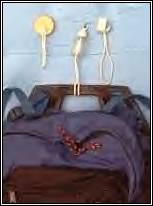
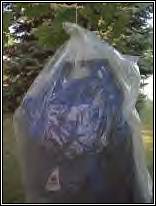
 seep into your tent. Self-inflatable pads are convenient and very comfortable but can be heavy, especially the full-length ones (2-3 lbs.). Closed-cell pads are light weight (10-16 oz.) and cost about one-quarter of what a self-inflatable one costs, however, they are bulky. Some newer closed-cell designs fold like an accordion. In spite of the weight and cost, I still prefer the self inflating variety; nothing beats a good night sleep after along day on the trail.
seep into your tent. Self-inflatable pads are convenient and very comfortable but can be heavy, especially the full-length ones (2-3 lbs.). Closed-cell pads are light weight (10-16 oz.) and cost about one-quarter of what a self-inflatable one costs, however, they are bulky. Some newer closed-cell designs fold like an accordion. In spite of the weight and cost, I still prefer the self inflating variety; nothing beats a good night sleep after along day on the trail.
 Goose necked heavy plastic bags should be used for items that must be kept dry but are too large for zip-lock bags, like a sleeping bag. The gooseneck closure is formed by twisting the bag end, folding it over, then fastening it in place with a rubber band or twine. If a stuff sack is lined with a plastic bag and is going to be compressed using webbing straps and buckles refrain from tying down the gooseneck until the compression is nearly complete or poke a pin hole in the bag to allow the remaining air to escape.
Goose necked heavy plastic bags should be used for items that must be kept dry but are too large for zip-lock bags, like a sleeping bag. The gooseneck closure is formed by twisting the bag end, folding it over, then fastening it in place with a rubber band or twine. If a stuff sack is lined with a plastic bag and is going to be compressed using webbing straps and buckles refrain from tying down the gooseneck until the compression is nearly complete or poke a pin hole in the bag to allow the remaining air to escape.